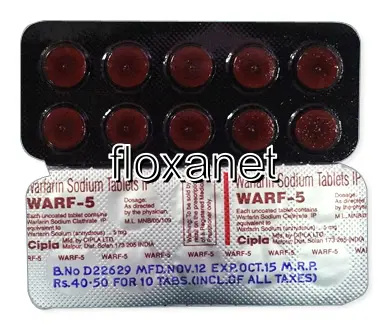| Package | Dosage | Price | Price per Dose | |
|---|---|---|---|---|
| Dosage: 1mg | ||||
| 360 pill | 1mg | $249.83 | $0.69 | |
| 180 pill | 1mg | $137.40 | $0.76 | |
| 120 pill | 1mg | $102.70 | $0.86 | |
| 90 pill | 1mg | $81.88 | $0.92 | |
| 60 pill | 1mg | $59.67 | $0.99 | |
| 30 pill | 1mg | $31.91 | $1.07 | |
| Dosage: 2mg | ||||
| 360 pill | 2mg | $299.79 | $0.83 | |
| 180 pill | 2mg | $162.38 | $0.90 | |
| 120 pill | 2mg | $116.58 | $0.97 | |
| 90 pill | 2mg | $94.37 | $1.05 | |
| 60 pill | 2mg | $70.77 | $1.18 | |
| 30 pill | 2mg | $40.24 | $1.36 | |
| Dosage: 5mg | ||||
| 360 pill | 5mg | $334.49 | $0.93 | |
| 240 pill | 5mg | $235.95 | $0.99 | |
| 180 pill | 5mg | $197.08 | $1.10 | |
| 120 pill | 5mg | $149.89 | $1.25 | |
| 90 pill | 5mg | $124.91 | $1.39 | |
| 60 pill | 5mg | $84.65 | $1.40 | |
| 30 pill | 5mg | $44.40 | $1.49 | |
| 20 pill | 5mg | $31.91 | $1.57 | |
| 10 pill | 5mg | $15.25 | $1.58 | |

Warfarin Description
Overview of Warfarin
Warfarin is a widely used anticoagulant medication that helps prevent and treat blood clots. It is often prescribed for conditions such as atrial fibrillation, deep vein thrombosis (DVT), pulmonary embolism, and after certain surgeries to reduce the risk of clot formation. Warfarin works by inhibiting the synthesis of vitamin K-dependent clotting factors, thus decreasing the blood's ability to clot. Its effectiveness makes it an essential medication in managing thromboembolic disorders.
How to Use Warfarin
Warfarin requires careful dosage adjustment to achieve the desired anticoagulant effect without increasing bleeding risks. The medication is usually taken orally, once daily, with the dosage determined by the patient's response, monitored through regular blood tests such as the International Normalized Ratio (INR). Patients need to maintain consistent daily routines and diet, especially regarding vitamin K intake, which can influence warfarin's effectiveness. It’s important to follow the prescribing instructions and attend regular check-ups to adjust the dose as needed.
Benefits of Warfarin
One of the main advantages of warfarin is its proven effectiveness in preventing blood clots. It has been used for decades with a well-established safety profile when properly managed. Warfarin helps reduce the risk of stroke in patients with atrial fibrillation and prevents the expansion or recurrence of thrombotic events. Its affordability and availability also contribute to its widespread use globally.
Possible Side Effects and Risks
As with any anticoagulant, warfarin carries a risk of bleeding complications. This can range from minor bruising to severe bleeding episodes, such as gastrointestinal bleeding or intracranial hemorrhages. Other side effects may include skin necrosis or purple toe syndrome, although these are rare. Patients should be aware of signs of bleeding and seek immediate medical attention if symptoms occur. Additionally, certain medications, foods, and illnesses can affect warfarin’s effectiveness, so interactions must be carefully managed.
Precautions and Interactions
Warfarin’s interaction profile makes it vital to coordinate with healthcare providers before using other medications or supplements. Drugs like antibiotics, antifungals, and certain pain relievers can increase bleeding risks. A diet rich in vitamin K, found in green leafy vegetables, can decrease warfarin’s effectiveness, requiring dose adjustments. It is essential for patients to disclose all medications and dietary habits to their healthcare team. Regular blood testing helps ensure that INR remains within a safe and effective range.
Conclusion
Warfarin remains a cornerstone in anticoagulant therapy due to its proven efficacy and affordability. However, its use demands diligent monitoring and lifestyle management to optimize benefits and reduce risks. Patients prescribed warfarin should maintain close communication with their healthcare providers, adhere to scheduled blood tests, and be vigilant about signs of bleeding or clotting complications. Proper management ensures that warfarin can safely provide significant protection against thromboembolic events.
